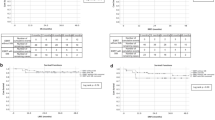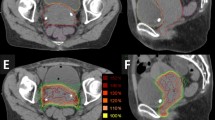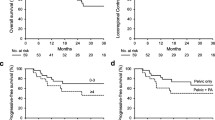Abstract
Purpose
It is standard for our department to offer intensity-modulated radiation therapy (IMRT) with simultaneous integrated boost (SIB) for all node-positive cervical cancer patients. Multiple institutions have provided reports and here we provide our outcomes using IMRT [Vargo et al. (Int J Rad Oncol Biol Phys 90: 1091–1098, 9), Marnitz et al. (Strahlentherapie und Onkol 191: 421–428, 10), Jung et al. (Anticancer Res 34: 4361–4366, 11), Zhang et al. (J Gynecol Oncol 25: 14–21, 12), Ke et al. (Zhonghua Fu Chan Ke Za Zhi 48: 649–653, 13)] .
Methods and materials
Thirty-four patients with cervical cancer (stages IBI–IVB) diagnosed from 2013 to 2014 getting definitive chemoradiotherapy with positive pelvic and para-aortic nodes treated with IMRT and concurrent weekly cisplatin were retrospectively analyzed. IMRT was administered to the pelvis at 1.8 Gy/day to 45–50.4 Gy with SIB at 2.07 Gy/day to 51.75–57.96 Gy. Patients were then treated with brachytherapy with point A to 85–90 Gy followed by a nodal boost to bring positive nodes to 60–66 Gy. Full and empty bladder simulations were done to assess cervical motion. Daily cone beam CTs were utilized to assess for internal organ motion and weight changes.
Results
The nodal location was pelvis-only in 16 patients (47%) and pelvis + para-aortic in 16 patients (47%). With a median follow-up time of 26 months (range 4–47 months), 16 patients experienced recurrence or persistent disease. The sites of recurrent/persistent disease were cervix 10 (29%), regional nodes 6 (18%), and distant 10 (29%). Two-year overall survival was 73% and 2-year disease-free survival was 59%. Fourteen patients (41%) experienced grade 2 and 1 patient (3%) experienced grade 3 GI toxicity.
Conclusions
In patients with PET-positive nodes, IMRT is well tolerated and provides good local control and overall survival.




Similar content being viewed by others
References
Siegel RL, Miller KD, Jemal A (2015) Cancer statistics, 2015. CA Cancer J Clin 65(1):5–29
Kidd EA et al (2010) Lymph node staging by positron emission tomography in cervical cancer: relationship to prognosis. J Clin Oncol 28(12):2108–2113
Grigsby PW et al (2001) Long-term follow-up of RTOG 92-10: cervical cancer with positive Para-aortic lymph nodes. Int J Radiat Oncol Biol Phys 51(4):982–987
Benard VB et al (2014) Vital signs: cervical cancer incidence, mortality, and screening—United States, 2007–2012. MMWR Morb Mortal Wkly Rep 63(44):1004–1009
Janerich DT et al (1995) The screening histories of women with invasive cervical cancer, Connecticut. Am J Public Health 85(6):791–794
Singleton, H., and J. Orr. Screening in Cancer of the Cervix. (1995), pp 17–35.
Behbakht K et al (2004) Social and cultural barriers to Papanicolaou test screening in an urban population. Obstet Gynecol 104(6):1355–1361
Phillips KA, Mayer ML, Aday LA (2000) Barriers to care among racial/ethnic groups under managed care. Health Aff 19(4):65–75
Vargo JA et al (2014) Extended field intensity modulated radiation therapy with concomitant boost for lymph node–positive cervical cancer: analysis of regional control and recurrence patterns in the positron emission tomography/computed tomography era. Int J Radiat Oncol Biol Phys 90(5):1091–1098
Marnitz S et al (2015) Extended field chemoradiation for cervical cancer patients with histologically proven Para-aortic lymph node metastases after laparaoscopic lymphadenectomy. Strahlenther Onkol 191(5):421–428
Jung J, Park G, Kim YS (2014) Definitive extended-field intensity-modulated radiotherapy with chemotherapy for cervical cancer with Para-aortic nodal metastasis. Anticancer Res 34(8):4361–4366
Zhang G et al (2014) Definitive extended field intensity-modulated radiotherapy and concurrent cisplatin chemosensitization in the treatment of IB2-IIIB cervical cancer. J Gynecol Oncol 25(1):14–21
Ke GH et al (2013) Extended-field intensity modulated radiation therapy and intra-cavitary brachytherapy combined with chemotherapy for stage Ib1-IVa cervical cancer with positive Para-aortic lymph nodes. Zhonghua fu chan ke za zhi 48(9):649–653
Small W et al (2008) Consensus guidelines for delineation of clinical target volume for intensity-modulated pelvic radiotherapy in postoperative treatment of endometrial and cervical cancer. Int J Radiat Oncol Biol Phys 71(2):428–434
“Common Terminology Criteria for Adverse Events (CTCAE)”, Version 4.0, Published May 28, 2009 (v4.03 June 14, 2010), U.S. Department of Health and Human Services, National Institutes of Health, National Cancer Institute.
Small W et al (2007) Extended-field irradiation and intracavitary brachytherapy combined with cisplatin chemotherapy for cervical cancer with positive Para-aortic or high common iliac lymph nodes: results of ARM 1 of RTOG 0116. Int J Radiat Oncol Biol Phys 68(4):1081–1087
Mundt AJ et al (2002) Intensity-modulated whole pelvic radiotherapy in women with gynecologic malignancies. Int J Radiat Oncol Biol Phys 52(5):1330–1337
Rose PG et al (1999) Concurrent cisplatin-based radiotherapy and chemotherapy for locally advanced cervical cancer. N Engl J Med 340(15):1144–1153
Keys HM et al (1999) Cisplatin, radiation, and adjuvant hysterectomy compared with radiation and adjuvant hysterectomy for bulky stage IB cervical carcinoma. N Engl J Med 340(15):1154–1161
Morris M et al (1999) Pelvic radiation with concurrent chemotherapy compared with pelvic and Para-aortic radiation for high-risk cervical cancer. N Engl J Med 340(15):1137–1143
Lanciano R et al (2005) Randomized comparison of weekly cisplatin or protracted venous infusion of fluorouracil in combination with pelvic radiation in advanced cervix cancer: a gynecologic oncology group study. J Clin Oncol 23(33):8289–8295
Pearcey R et al (2002) Phase III trial comparing radical radiotherapy with and without cisplatin chemotherapy in patients with advanced squamous cell cancer of the cervix. J Clin Oncol 20(4):966–972
Butler EB et al (1999) Smart (simultaneous modulated accelerated radiation therapy) boost: a new accelerated fractionation schedule for the treatment of head and neck cancer with intensity modulated radiotherapy. Int J Radiat Oncol Biol Phys 45(1):21–32
Shirvani SM et al (2013) Intensity modulated radiation therapy for definitive treatment of paraortic relapse in patients with endometrial cancer. Practical radiation oncology 3(1):e21–e28
Fokdal, Lars, et al. Image guided adaptive brachytherapy with combined intracavitary and interstitial technique improves the therapeutic ratio in locally advanced cervical cancer: Analysis from the retroEMBRACE study. Radiotherapy and Oncology (2016).
Acknowledgements
The following research was presented on April 16 at the 2016 meeting of the American Radium Society.
Author information
Authors and Affiliations
Corresponding author
Ethics declarations
Funding
No funding was required for this study.
Conflict of interest
The authors declare that they have no conflict of interest.
Ethical approval
All procedures performed in this study were in accordance with the ethical standards of the institutional review board (IRB) and with the 1964 Helsinki declaration and its later amendments or comparable ethical standards. IRB approval was obtained for the retrospective chart review prior to beginning the study.
This article does not contain any studies with human or animal subjects performed by any of the authors.
Informed consent
The IRB permitted waiving the informed consent since this is a retrospective patterns of care study.
Rights and permissions
About this article
Cite this article
Shumway, J.W., Echeverria, A.E., Patel, U. et al. Effectiveness of intensity-modulated radiation therapy with simultaneous integrated boost in cervical cancer patients with PET positive lymph nodes. J Radiat Oncol 6, 167–173 (2017). https://doi.org/10.1007/s13566-017-0294-7
Received:
Accepted:
Published:
Issue Date:
DOI: https://doi.org/10.1007/s13566-017-0294-7




